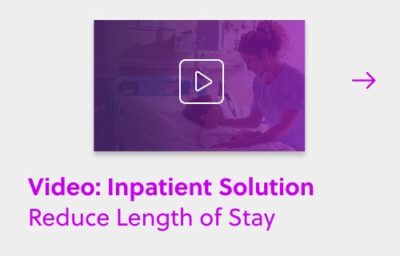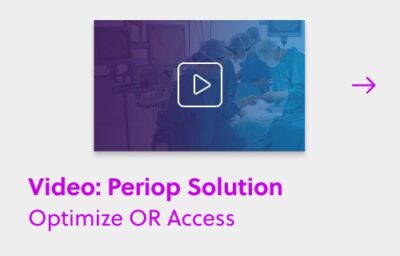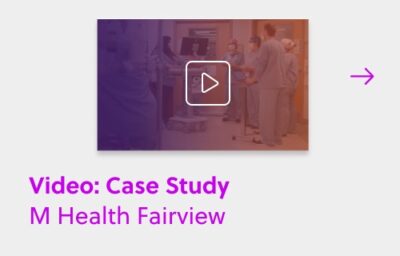Qventus often hosts healthcare leaders in our office to share insights about the challenges and opportunities driving change in the delivery of care. We recently had the honor of hosting Edmondo Robinson, M.D., MBA, FACP, Chief Transformation Officer of Christiana Care Health System. After our lunch and learn we spent time with Dr. Robinson to talk about what transformation means for healthcare.
![]()
Edmondo Robinson, M.D., MBA, FACP is Chief Transformation Officer at Christiana Care Health System, where he carries out projects that focus on innovation in healthcare delivery. He is an Associate Professor of Medicine at Thomas Jefferson University’s Medical College and a practicing internist. We asked Dr. Robinson a few questions about his role at Christiana Care and his perspective on new technologies in healthcare, namely AI and machine learning.
As Chief Transformation Officer, where do you see the intersection of technology and patient care? What is technology’s role with respect to this intersection?
Technology is not the ultimate solution to a problem. However, that doesn’t mean that technology has no role in healthcare because it is obviously a big part of what I do on a regular basis.
While I think it’s necessary to have an intersection in terms of the patient journey and care delivery, the truth is that health care begins with the people we serve. In the Office of Transformation, we spend 80 to 85 percent of our project time and effort on the people who provide care and the people we provide care to – any innovation or transformation comes second and serves to accelerate transformation only if developed in a way that puts people at the forefront.
Which tools or technologies today have had the most impact on care and hospital operations?
I would confidently say the Electronic Medical Record (EMR). No other tool comes close – I’m not even sure what would be second on the list. It has had an impact on all hospital operations – both in a positive and negative way.
Could you give us examples of how the EMR has been both a positive and negative?
Let’s talk about the positives first – namely, medication safety. If I try to prescribe a medication to a patient who has a documented allergy, I will get two or three pop-ups – in the EMR, that’s ultimately a good thing. This notification process creates an added awareness that is saving lives by decreasing adverse drug events. Hence, I consider that an important positive.
The negative aspect is that the more complex these systems are, the more they slow down the average clinician who is just trying to take care of patients. The EMR was not designed with the provider or the patient in mind but was in fact designed as a transactional tool and falls short on providing a good user experience for any of its users.
Why have EMRs failed to live up to the needs of clinicians?
There are some processes that go towards the appropriate capture of revenue in order to maintain revenue cycle management, essentially clinical documentation – the EMR was a way to digitize those processes. It definitely wasn’t designed to communicate seamlessly between providers or for an outstanding consumer experience.
What new technology shows promise in supporting your healthcare team?
I don’t think there’s a specific technology that will revolutionize the care world. What I do believe is that caregivers are going to understand that they should approach the delivery of care through a consumer lens. I think that’s going to be one of the most powerful things that we do. Therefore, it wouldn’t be a specific technology, but instead an approach to how we engage with those we serve.
Leaders in other industries, air travel, retail, etc., have built their organizations around this concept and we’re just turning to it now.
Tell us a little bit more about what change management and adoption look like to you.
Let me begin by explaining my take on the difference between innovation and transformation. Innovation is something that is new to us with an uncertain outcome. If we know the outcome, it’s implementation.
When an innovation fails, it usually does not transform the organization. Transformation is taking those innovations and implementing them so that over the long haul you have a new way of doing things in your organization – in other words, you have transformed the way the organization looks or functions or interacts.
What does your team at Christiana Care look like?
I have a small and nimble team that focuses on collaboration with internal stakeholders and leveraging system resources to achieve strategic aims. For an organization of our size (about $2B in revenue), a five to six-person team that is hyper-focused on transformation through collaboration and implementation is enough to significantly transform the business.
As a leader for transformation, my approach is to tightly align the goals of the Office of Transformation with system-level goals in order to achieve our mission and business objectives.
Have you, in your explorations, seen any interesting AI technologies being applied in healthcare?
I think AI in healthcare is a little further along than blockchain, or maybe a lot further along, depending on whether you’re looking at supply chain or actual delivery of care. One of the more common applications is the utilization of machine learning around the prediction of sepsis and other complications for hospitalized patients, in order to intervene early.
I think machines are inevitably going to get smarter and will change how we deliver and optimize delivery of care from an imaging perspective as well.
At Christiana Care, we have in place machine learning algorithms that allow us to help manage at-risk populations. We have a system that pulls data from our statewide health information exchange – that we call the Delaware Health Information Network (DHIN) — and our own internal clinical data. The algorithms get better at being able to point us in the direction of people who need our attention. This tool was co-developed several years ago along with a Philadelphia-based company that was working on predictive analytics and machine learning in a completely unrelated field.
What would you say to your peers considering appliances in machine learning or AI?
It’s probably the same thing I would say about telehealth – it’s not the destination or the solution. What I would say to my peers is: have the appropriate tools ready to accomplish your goal and leverage AI/machine learning if they are the right tools to achieve your goal.
For example, if your goal is to decrease readmission rates, it would be essential to have machine learning algorithms around predictive analytics on people who might get readmitted along with possible solutions. However, other effective tools such as in-home monitoring, skilled nursing facility collaborations, robust medication reconciliation and home visiting programs (just to name a few) should also be your toolbox.
Are there any other insights that people should consider about the adoption of technology and its possible potential to help healthcare organizations?
When you’re driving innovation towards transformation, you may need to give the frontline staff a chance to step away from their day-to-day duties and come up with solutions. Chances are, the solutions are not in the C-suite and it is important to create an environment that allows you to solicit solutions from the people who are much more likely to come up with valuable insights.


